MAZDA MODEL MAZDASPEED 3 2013 Owners Manual (in English)
Manufacturer: MAZDA, Model Year: 2013, Model line: MODEL MAZDASPEED 3, Model: MAZDA MODEL MAZDASPEED 3 2013Pages: 611, PDF Size: 7.02 MB
Page 181 of 611

WARNING
Do not use engine braking on slippery
road surfaces or at high speeds:
Shifting down while driving on wet,
snowy, or frozen roads, or while
driving at high speeds causes sudden
engine braking, which is dangerous.
The sudden change in tire speed
could cause the tires to skid. This
could lead to loss of vehicle control
and an accident.
NOTE
lWhen driving at high speeds, the gear may
not shift down.
lDuring deceleration, the gear may
automatically shift down depending on
vehicle speed.
lWhen depressing the accelerator fully, the
transaxle will shift to a lower gear,
depending on vehicle speed (Except M2→
M1).
Second gear fixed mode
When the shift lever is tapped back (
)
while the vehicle is stopped or driven at
the following speeds, the transaxle is set
in the second gear fixed mode.
SKYACTIV-G 2.0 model:
10.1 km/h (6.27 mph) or less
MZR 2.0, MZR 2.5 model:
12 km/h (7.5 mph) or less
The gear is fixed in second while in this
mode for easier starting and driving on
slippery roads. If the shift lever is tapped
back (
) or forward () while in the
second gear fixed mode, the mode will be
canceled.
Shifting specification
Shifting up
If the vehicle speed is lower than the
speed specified for each gear, the gear
cannot be shifted up to a higher gear.
(MZR 2.0)
Gear Vehicle speed
M1→M2You can shift up to M2 whether the
vehicle is stopped or moving.
M2→M3 20.5 km/h (12.8 mph)
M3→M4
37 km/h (23 mph)
M4→M5
(SKYACTIV-G 2.0)
Gear Vehicle speed
M1→M2 10.1 km/h (6.28 mph)
M2→M3 25.6 km/h (16.0 mph)
M3→M4 35.2 km/h (21.9 mph)
M4→M5 55 km/h (35 mph)
M5→M6 70 km/h (44 mph)
(MZR 2.5)
Gear Vehicle speed
M1→M2You can shift up to M2 whether the
vehicle is stopped or moving.
M2→M3 20.5 km/h (12.8 mph)
M3→M4
34 km/h (22 mph)
M4→M5
Shifting down
If the vehicle speed is higher than the
speed specified for each gear, the gear
cannot be shifted to a lower gear so as to
protect the transaxle.
(MZR 2.0)
Gear Vehicle speed
M5→M4 213 km/h (132 mph)
M4→M3 153 km/h (95 mph)
M3→M2 100 km/h (62 mph)
M2→M1 40 km/h (24 mph)
5-18
Driving Your Mazda
Starting and Driving
Page 182 of 611

(SKYACTIV-G 2.0)
Gear Vehicle speed
M6→M5 271.1 km/h (168.4 mph)
M5→M4 192 km/h (119 mph)
M4→M3 132.2 km/h (82.14 mph)
M3→M2 94.9 km/h (58.9 mph)
M2→M1 54 km/h (33 mph)
(MZR 2.5)
Gear Vehicle speed
M5→M4 196 km/h (121 mph)
M4→M3 135 km/h (83 mph)
M3→M2 90 km/h (55 mph)
M2→M1 37 km/h (22 mph)
NOTE
Regarding the vehicle speed at the highest
gear indicated above, achieving this speed
may not actually be possible depending on
various driving conditions such as the wind,
upslope, and road surface.
During deceleration, the gears shift down
automatically when speed is reduced to
the following:
(SKYACTIV-G 2.0)
Gear Vehicle speed
M6→M5 66.8 km/h (41.5 mph)
M5→M4 53 km/h (32 mph)
M4→M3 32 km/h (19 mph)
M3→M2 13.7 km/h (8.51 mph)
M2→M1 7.1 km/h (4.4 mph)
(MZR 2.0, MZR 2.5)
Gear Vehicle speed
M5 or M4→
M331 km/h (19 mph)
M3 or M2→
M110 km/h (6 mph)
NOTE
The gear does not shift down to M1
automatically while in the second gear fixed
mode.
If the vehicle is kicked down at the
following speeds or lower, the gears shift
down automatically:
(MZR 2.0)
Gear Vehicle speed
M5→M4 199 km/h (123 mph)
M4→M3 146 km/h (90 mph)
M3→M2 54 km/h (33 mph)
(SKYACTIV-G 2.0)
Gear Vehicle speed
M6→M5 248.5 km/h (154.4 mph)
M5→M4 160 km/h (99.4 mph)
M4→M3 66.1 km/h (41.0 mph)
M3→M2 47.4 km/h (29.4 mph)
(MZR 2.5)
Gear Vehicle speed
M5→M4 183 km/h (113 mph)
M4→M3 126 km/h (78 mph)
M3→M2 51 km/h (31 mph)
Recommendations for shifting
Upshifting
For normal acceleration and cruising, we
recommend these shift points.
(SKYACTIV-G 2.0)
Gear Vehicle speed
M1 to M2 24 km/h (15 mph)
M2 to M3 40 km/h (25 mph)
M3 to M4 65 km/h (40 mph)
M4 to M5 73 km/h (45 mph)
M5 to M6 81 km/h (50 mph)
(MZR 2.0, MZR 2.5)
Gear Vehicle speed
M1 to M2 24 km/h (15 mph)
M2 to M3 40 km/h (25 mph)
M3 to M4 65 km/h (40 mph)
M4 to M5 73 km/h (45 mph)
Driving Your Mazda
Starting and Driving
5-19
Page 183 of 611
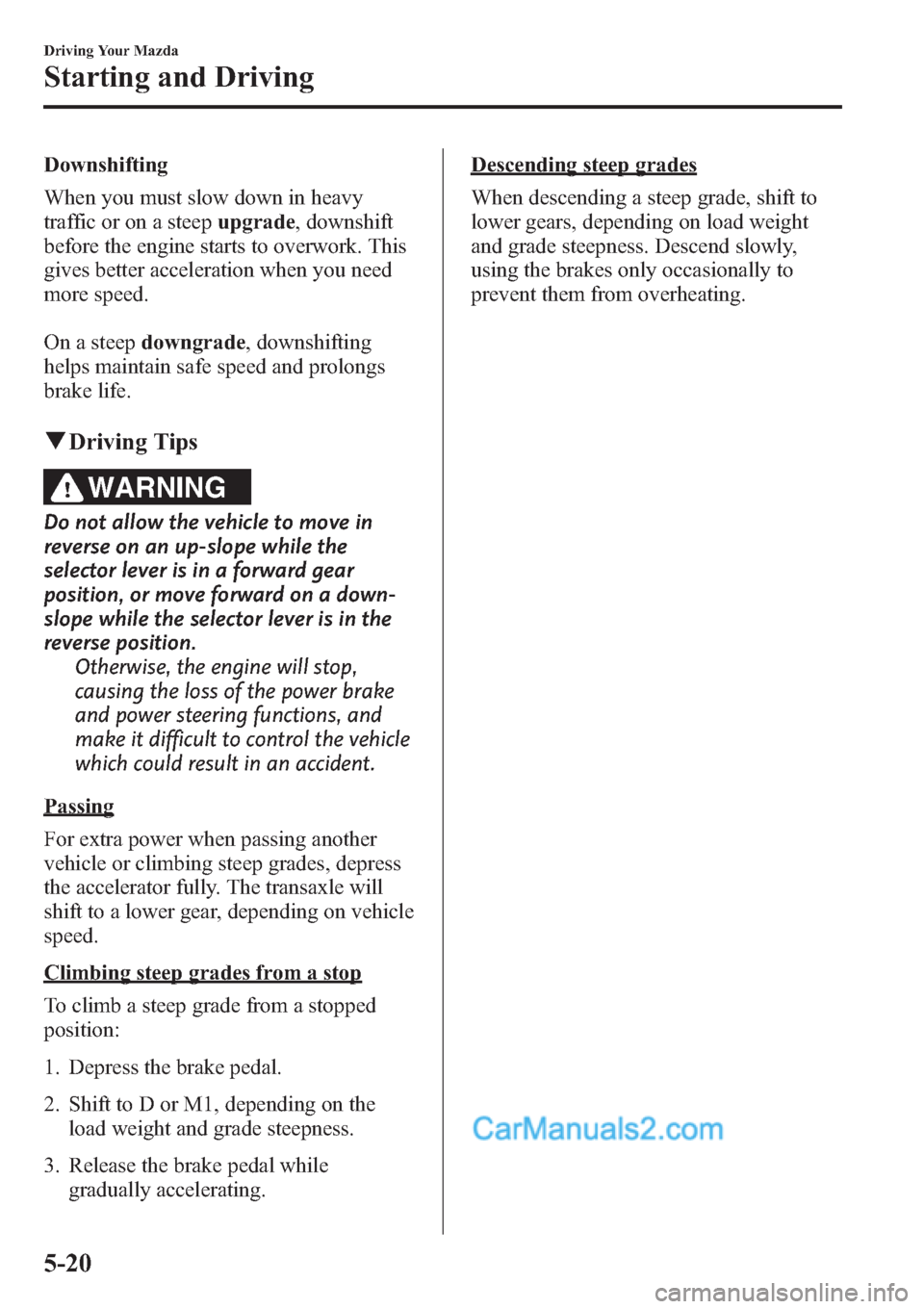
Downshifting
When you must slow down in heavy
traffic or on a steepupgrade, downshift
before the engine starts to overwork. This
gives better acceleration when you need
more speed.
On a steepdowngrade, downshifting
helps maintain safe speed and prolongs
brake life.
qDriving Tips
WARNING
Do not allow the vehicle to move in
reverse on an up-slope while the
selector lever is in a forward gear
position, or move forward on a down-
slope while the selector lever is in the
reverse position.
Otherwise, the engine will stop,
causing the loss of the power brake
and power steering functions, and
make it difficult to control the vehicle
which could result in an accident.
Passing
For extra power when passing another
vehicle or climbing steep grades, depress
the accelerator fully. The transaxle will
shift to a lower gear, depending on vehicle
speed.
Climbing steep grades from a stop
To climb a steep grade from a stopped
position:
1. Depress the brake pedal.
2. Shift to D or M1, depending on the
load weight and grade steepness.
3. Release the brake pedal while
gradually accelerating.
Descending steep grades
When descending a steep grade, shift to
lower gears, depending on load weight
and grade steepness. Descend slowly,
using the brakes only occasionally to
prevent them from overheating.
5-20
Driving Your Mazda
Starting and Driving
Page 184 of 611
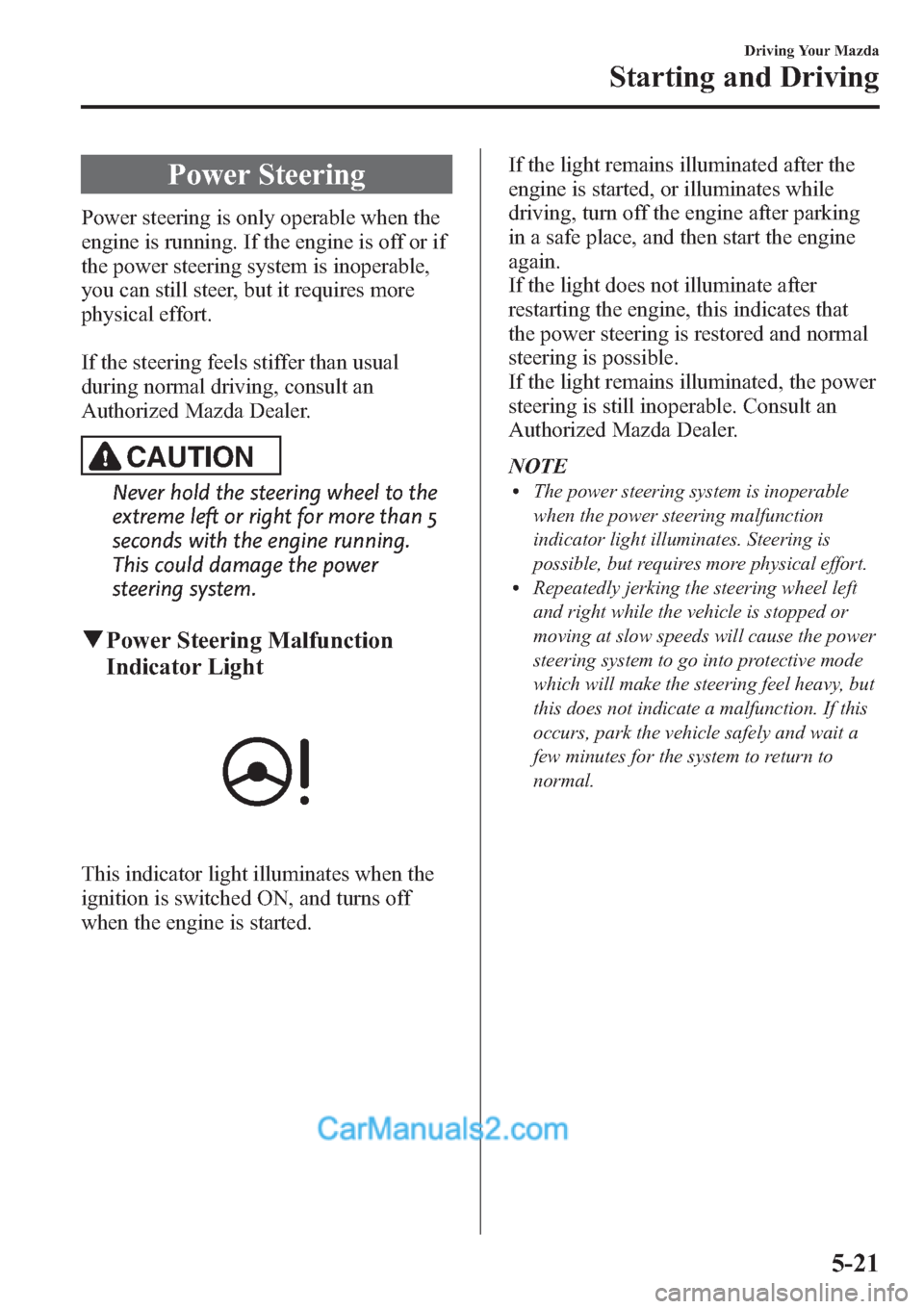
Power Steering
Power steering is only operable when the
engine is running. If the engine is off or if
the power steering system is inoperable,
you can still steer, but it requires more
physical effort.
If the steering feels stiffer than usual
during normal driving, consult an
Authorized Mazda Dealer.
CAUTION
Never hold the steering wheel to the
extreme left or right for more than 5
seconds with the engine running.
This could damage the power
steering system.
qPower Steering Malfunction
Indicator Light
This indicator light illuminates when the
ignition is switched ON, and turns off
when the engine is started.If the light remains illuminated after the
engine is started, or illuminates while
driving, turn off the engine after parking
in a safe place, and then start the engine
again.
If the light does not illuminate after
restarting the engine, this indicates that
the power steering is restored and normal
steering is possible.
If the light remains illuminated, the power
steering is still inoperable. Consult an
Authorized Mazda Dealer.
NOTE
lThe power steering system is inoperable
when the power steering malfunction
indicator light illuminates. Steering is
possible, but requires more physical effort.
lRepeatedly jerking the steering wheel left
and right while the vehicle is stopped or
moving at slow speeds will cause the power
steering system to go into protective mode
which will make the steering feel heavy, but
this does not indicate a malfunction. If this
occurs, park the vehicle safely and wait a
few minutes for the system to return to
normal.
Driving Your Mazda
Starting and Driving
5-21
Page 185 of 611
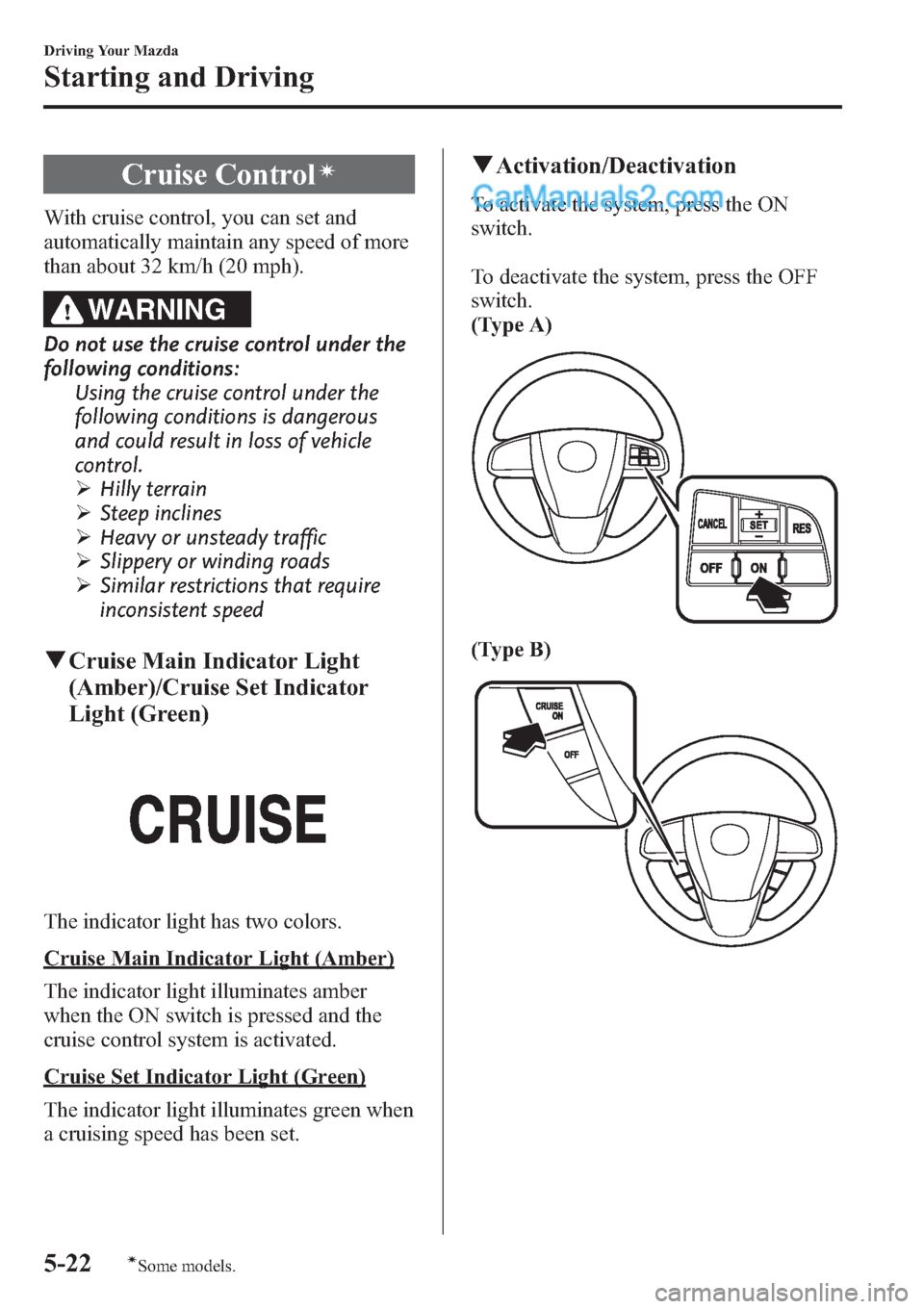
Cruise Controlí
With cruise control, you can set and
automatically maintain any speed of more
than about 32 km/h (20 mph).
WARNING
Do not use the cruise control under the
following conditions:
Using the cruise control under the
following conditions is dangerous
and could result in loss of vehicle
control.
ØHilly terrain
ØSteep inclines
ØHeavy or unsteady traffic
ØSlippery or winding roads
ØSimilar restrictions that require
inconsistent speed
qCruise Main Indicator Light
(Amber)/Cruise Set Indicator
Light (Green)
The indicator light has two colors.
Cruise Main Indicator Light (Amber)
The indicator light illuminates amber
when the ON switch is pressed and the
cruise control system is activated.
Cruise Set Indicator Light (Green)
The indicator light illuminates green when
a cruising speed has been set.
qActivation/Deactivation
To activate the system, press the ON
switch.
To deactivate the system, press the OFF
switch.
(Type A)
(Type B)
5-22
Driving Your Mazda
íSome models.
Starting and Driving
Page 186 of 611
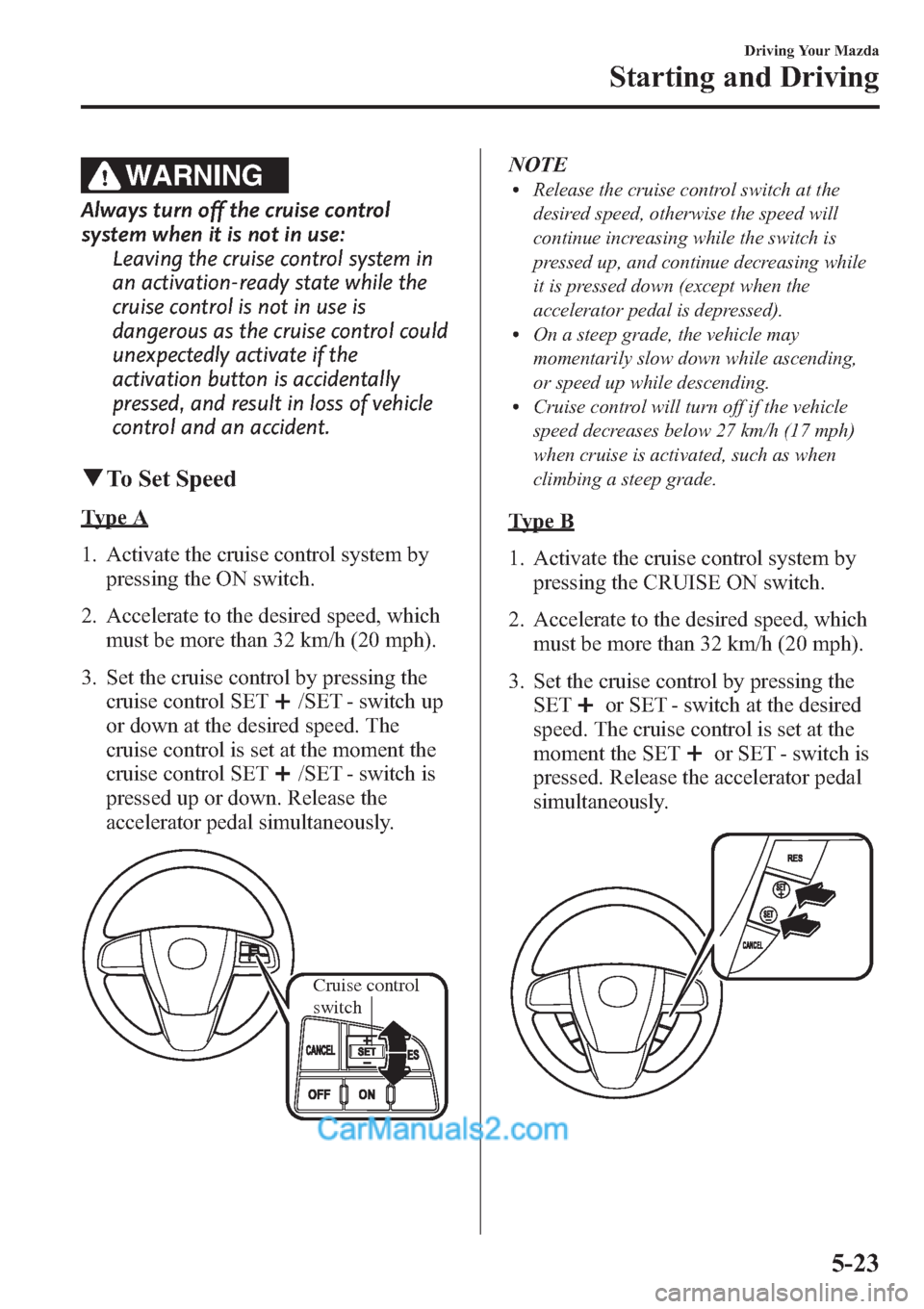
WARNING
Always turn off the cruise control
system when it is not in use:
Leaving the cruise control system in
an activation-ready state while the
cruise control is not in use is
dangerous as the cruise control could
unexpectedly activate if the
activation button is accidentally
pressed, and result in loss of vehicle
control and an accident.
qTo Set Speed
Type A
1. Activate the cruise control system by
pressing the ON switch.
2. Accelerate to the desired speed, which
must be more than 32 km/h (20 mph).
3. Set the cruise control by pressing the
cruise control SET
/SET - switch up
or down at the desired speed. The
cruise control is set at the moment the
cruise control SET
/SET - switch is
pressed up or down. Release the
accelerator pedal simultaneously.
Cruise control
switch
NOTElRelease the cruise control switch at the
desired speed, otherwise the speed will
continue increasing while the switch is
pressed up, and continue decreasing while
it is pressed down (except when the
accelerator pedal is depressed).
lOn a steep grade, the vehicle may
momentarily slow down while ascending,
or speed up while descending.
lCruise control will turn off if the vehicle
speed decreases below 27 km/h (17 mph)
when cruise is activated, such as when
climbing a steep grade.
Type B
1. Activate the cruise control system by
pressing the CRUISE ON switch.
2. Accelerate to the desired speed, which
must be more than 32 km/h (20 mph).
3. Set the cruise control by pressing the
SET
or SET - switch at the desired
speed. The cruise control is set at the
moment the SET
or SET - switch is
pressed. Release the accelerator pedal
simultaneously.
Driving Your Mazda
Starting and Driving
5-23
Page 187 of 611
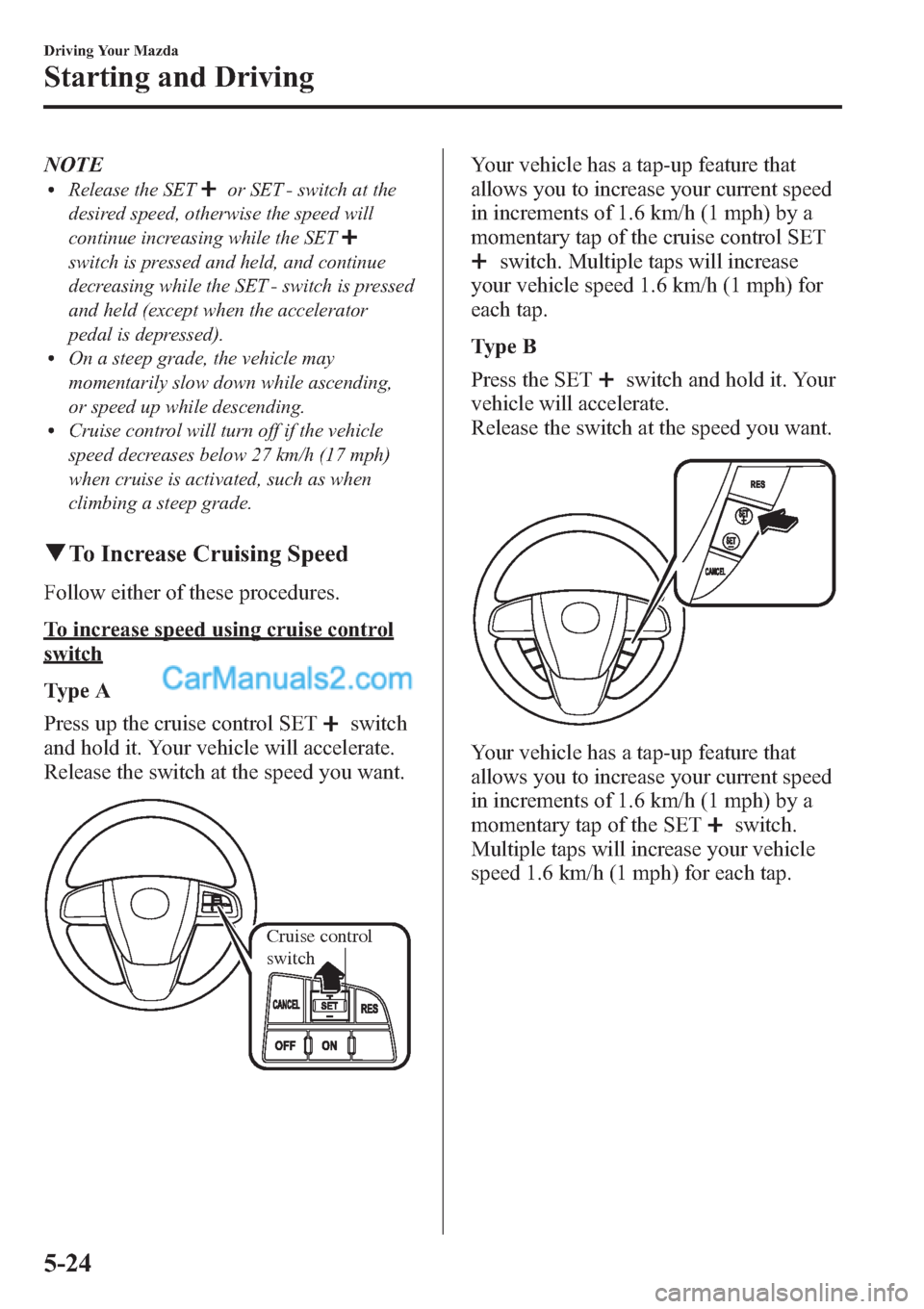
NOTElRelease the SETor SET - switch at the
desired speed, otherwise the speed will
continue increasing while the SET
switch is pressed and held, and continue
decreasing while the SET - switch is pressed
and held (except when the accelerator
pedal is depressed).
lOn a steep grade, the vehicle may
momentarily slow down while ascending,
or speed up while descending.
lCruise control will turn off if the vehicle
speed decreases below 27 km/h (17 mph)
when cruise is activated, such as when
climbing a steep grade.
qTo Increase Cruising Speed
Follow either of these procedures.
To increase speed using cruise control
switch
Type A
Press up the cruise control SET
switch
and hold it. Your vehicle will accelerate.
Release the switch at the speed you want.
Cruise control
switch
Your vehicle has a tap-up feature that
allows you to increase your current speed
in increments of 1.6 km/h (1 mph) by a
momentary tap of the cruise control SET
switch. Multiple taps will increase
your vehicle speed 1.6 km/h (1 mph) for
each tap.
Type B
Press the SET
switch and hold it. Your
vehicle will accelerate.
Release the switch at the speed you want.
Your vehicle has a tap-up feature that
allows you to increase your current speed
in increments of 1.6 km/h (1 mph) by a
momentary tap of the SET
switch.
Multiple taps will increase your vehicle
speed 1.6 km/h (1 mph) for each tap.
5-24
Driving Your Mazda
Starting and Driving
Page 188 of 611
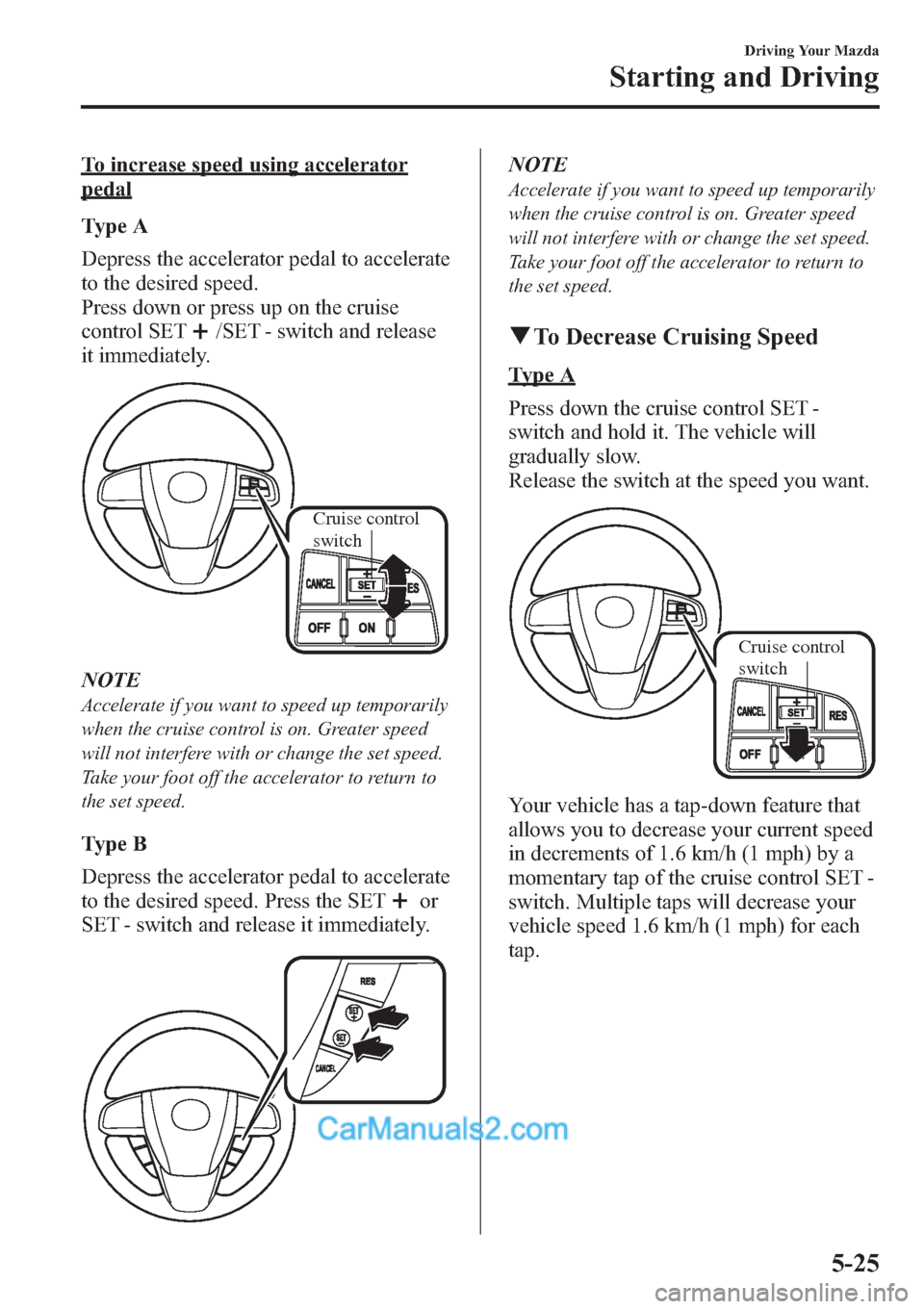
To increase speed using accelerator
pedal
Type A
Depress the accelerator pedal to accelerate
to the desired speed.
Press down or press up on the cruise
control SET
/SET - switch and release
it immediately.
Cruise control
switch
NOTE
Accelerate if you want to speed up temporarily
when the cruise control is on. Greater speed
will not interfere with or change the set speed.
Take your foot off the accelerator to return to
the set speed.
Type B
Depress the accelerator pedal to accelerate
to the desired speed. Press the SET
or
SET - switch and release it immediately.
NOTE
Accelerate if you want to speed up temporarily
when the cruise control is on. Greater speed
will not interfere with or change the set speed.
Take your foot off the accelerator to return to
the set speed.
qTo Decrease Cruising Speed
Type A
Press down the cruise control SET -
switch and hold it. The vehicle will
gradually slow.
Release the switch at the speed you want.
Cruise control
switch
Your vehicle has a tap-down feature that
allows you to decrease your current speed
in decrements of 1.6 km/h (1 mph) by a
momentary tap of the cruise control SET -
switch. Multiple taps will decrease your
vehicle speed 1.6 km/h (1 mph) for each
tap.
Driving Your Mazda
Starting and Driving
5-25
Page 189 of 611

Type B
Press the SET - switch and hold it. The
vehicle will gradually slow.
Release the switch at the speed you want.
Your vehicle has a tap-down feature that
allows you to decrease your current speed
in decrements of 1.6 km/h (1 mph) by a
momentary tap of the SET- switch.
Multiple taps will decrease your vehicle
speed 1.6 km/h (1 mph) for each tap.
qTo Resume Cruising Speed at
More Than 32 km/h (20 mph)
If some other method besides the OFF
switch was used to cancel cruising speed
(such as applying the brake pedal) and the
system is still activated, the most recent
set speed will automatically resume when
the RES switch is pressed.
If vehicle speed is below 32 km/h (20
mph), increase the vehicle speed up to 32
km/h (20 mph) or more and press the RES
switch.(Type A)
(Type B)
qTo Cancel
To cancel the system, useoneof these
methods:
lPress the OFF switch.lSlightly depress the brake pedal.lDepress the clutch pedal (Manual
transaxle only).
lPress the CANCEL switch.
5-26
Driving Your Mazda
Starting and Driving
Page 190 of 611
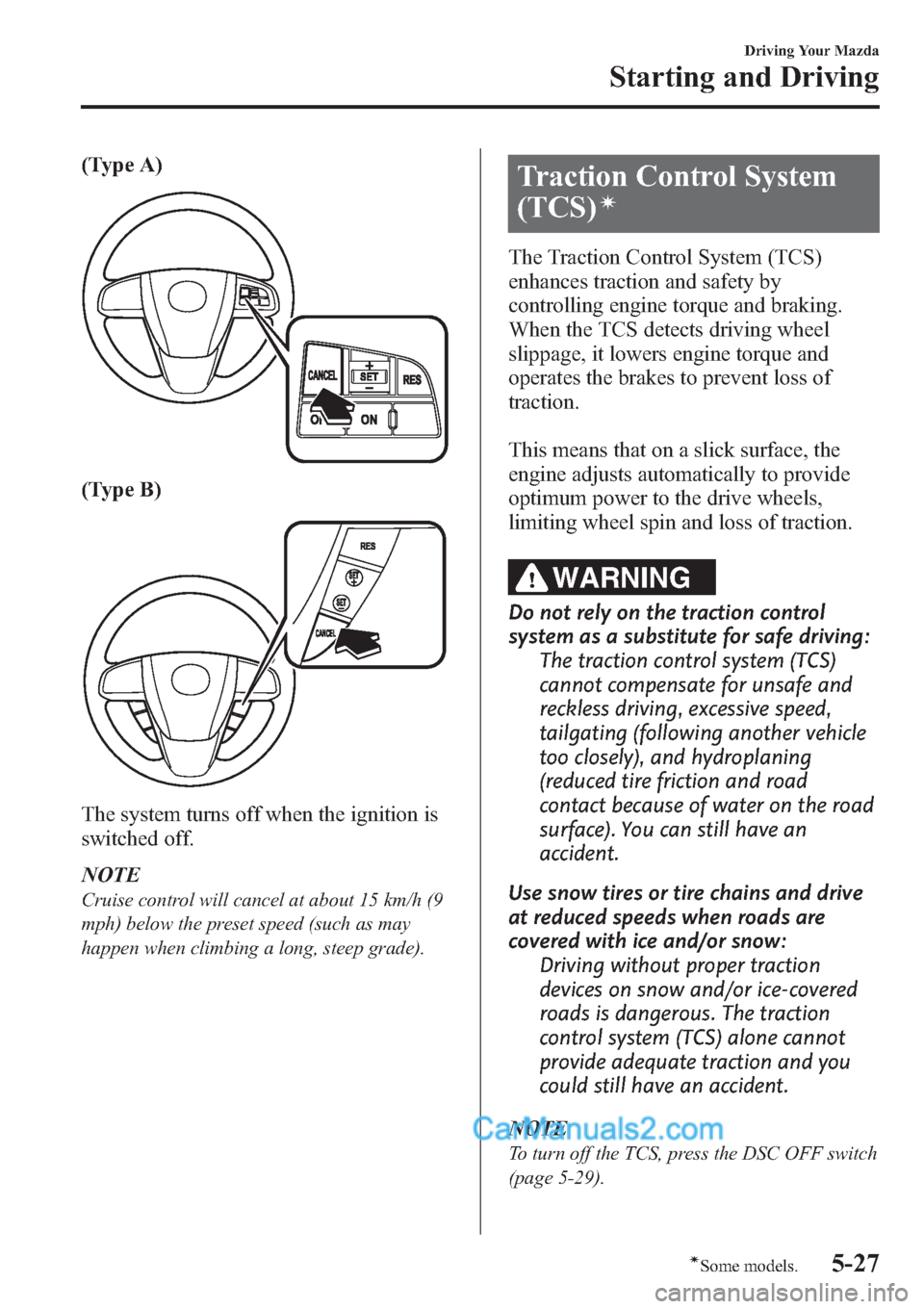
(Type A)
(Type B)
The system turns off when the ignition is
switched off.
NOTE
Cruise control will cancel at about 15 km/h (9
mph) below the preset speed (such as may
happen when climbing a long, steep grade).
Traction Control System
(TCS)
í
The Traction Control System (TCS)
enhances traction and safety by
controlling engine torque and braking.
When the TCS detects driving wheel
slippage, it lowers engine torque and
operates the brakes to prevent loss of
traction.
This means that on a slick surface, the
engine adjusts automatically to provide
optimum power to the drive wheels,
limiting wheel spin and loss of traction.
WARNING
Do not rely on the traction control
system as a substitute for safe driving:
The traction control system (TCS)
cannot compensate for unsafe and
reckless driving, excessive speed,
tailgating (following another vehicle
too closely), and hydroplaning
(reduced tire friction and road
contact because of water on the road
surface). You can still have an
accident.
Use snow tires or tire chains and drive
at reduced speeds when roads are
covered with ice and/or snow:
Driving without proper traction
devices on snow and/or ice-covered
roads is dangerous. The traction
control system (TCS) alone cannot
provide adequate traction and you
could still have an accident.
NOTE
To turn off the TCS, press the DSC OFF switch
(page 5-29).
Driving Your Mazda
Starting and Driving
5-27íSome models.